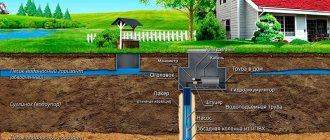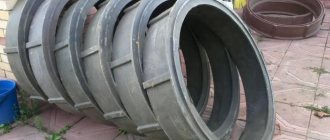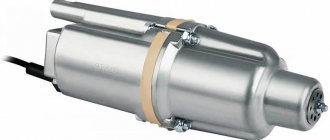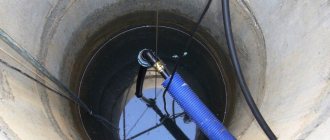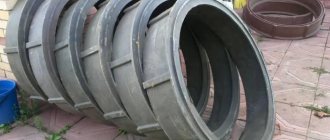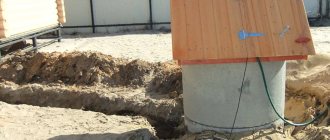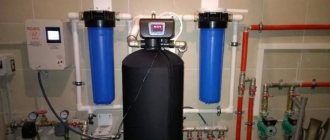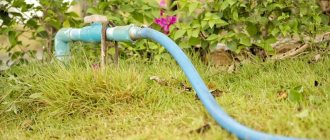Water in fresh springs in summer cottages becomes contaminated over time and becomes unsuitable for use - which is why regular cleaning of the well is required. Thanks to this procedure, various deposits on the walls of the shaft are eliminated, the seams are sealed, soil is prevented from getting inside, the well bottom is also cleared of siltation and the filtration system is changed.
Irregular cleaning leads to water contamination Source aquasistem.ru
How do you know when it's time?
There are many factors that indicate that it is time to clean your well. In order to achieve the best results when performing this work, it is important to know the cause and root of the problem. There are several signs:
- unpleasant odor;
- color;
- the presence of impurities, etc.
The most common problems:
| Problem | Consequences and causes |
| Silting | As a result, the liquid becomes cloudy. Clay and sand deposits are observed at the bottom |
| Oil film | Sign of petroleum products. The reason may be depressurization of the mine |
| Rusty water | This is explained by the large amount of iron in the liquid. |
| Bacteria | When water from a source is rarely used, bacteria grow in it. The cause may be household waste that has fallen into the mine, such as animals/birds, etc. |
| Unpleasant smell | One of the reasons is sewage infiltration |
| Green water | The cause may come down to algae. Germinate when exposed to large amounts of sunlight |
| Muddy water | In most cases, the reason for this is a failed bottom filter. |
Cleaning is also required when you notice a decrease in the fluid level. In almost all cases, this work can be done independently, without the involvement of specialists.
Installation of the bottom filter
A properly installed bottom filter is the most important element of rough cleaning, stopping the invasion of sand and clay. To form this protection, only natural materials are used that are not washed away by water. Be sure to place them in several layers to ensure complete safety for those using well water. should be taken into account that in dense soils of clay origin when obtaining water from underground springs, a filter will not be required.
But when the bottom is composed of soft clay and the water flows with significant pressure, the fight against turbid suspension is very important.
Large crushed stone or pebbles laid out in a layer of 0.15-0.2 m will help prevent the bottom from washing out. If the base of the pit is made of sand and water flows in even portions, you will need to lay out the filter yourself. It is also required in cases where there is quicksand below.
The direct type of bottom filter is used where the inflow is relatively small, as well as on top of quicksand. First, material of large fractions is laid out, then medium and small fractions (each layer is 5-6 times finer than the previous one).
The upper filter surface in such a system is made of quartz sand or pebbles. If the bottom is already sandy, reverse filters are used. Their main task is to prevent dirt from entering the water from reaching the bottom of the well. At the same time, owners are protected from contamination of the liquid by grains of sand rising in the flow of spring water. The difference from the direct scheme is that the sequence of layers is reversed; The thickness of each layer is a maximum of 150 mm.
How often will it be correct?
Ideally, once a year. The spring season is predominantly chosen.
Advice : even if you don’t experience any of the signs listed above, preventive cleaning will get rid of possible problems.
Regardless of whether you carry out preventive maintenance or routine cleaning of the source, it should be done on time, when the snow has completely melted. Otherwise, there is a risk that the drained liquid will return to the source through the high water.
Where does waste come from?
In the process of life, every organism that eats and drinks releases some kind of waste, most often biological, into the surrounding world.
Man manages to produce more waste than other living organisms.
- leftover food (when washing dishes);
- fragments of materials (when washing clothes);
- hair and skin discharge (during water procedures);
- other biological secretions of the human body.
Almost all waste products contain solid compounds that have the ability to accumulate, clog the sewer system and interfere with its normal functioning.
Methods for cleaning a mine in a country house from silt and dirt
There are two main methods:
- To go down.
- Don't go down.
In the first case, serious precautions must be taken to complete the work. But you can achieve a better result, because you can really see what is happening at the bottom of the source.
The second method is a safe method. To solve the problem, special pumping and other equipment is used.
Carelessness can be fatal for a worker. There are a number of measures you should definitely take:
- You should not do the work yourself: at least three people.
- When descending into a mine, a safety rope attached to the belt must be used.
- Before starting, make sure there are no gases.
- If tools fall from above, the worker below must press as tightly as possible against the wall. Moreover, work should be carried out wearing a protective helmet.
- It is unacceptable to stand at the bottom of a well at one point for a long time.
- You should not cleanse those who have heart problems.
- The ladder used must have a platform at the bottom and be securely hooked to the top with a rope.
- Use reliable equipment, including a bucket, rope, etc.
Which pump is better to clean?
Before purchasing a well cleaning device, you need to study the list of proven manufacturing brands. These are usually classified as:
- Unipump – Russia. A fairly well-known plant that has proven itself for a very long time. It is engaged not only in the production of caissons, but also other building materials.
- Grundfoss - Denmark. The company is known throughout Europe and is in great demand.
- Vilo Nova - Germany. The brand has long established itself in the market and has no negative reviews from customers.
- DAB - Italy. Specializes in the production of plastic materials. If you buy products from this brand, you definitely won’t regret it.
- Comfort - Russia. The choice of thousands of buyers, which was not unsuccessful.
- Aquario - Italy. Also considered one of the best manufacturers of construction equipment.
- Marina - Italy.
Manual cleaning: what needs to be prepared?
Prepare the following tools, materials and clothing in advance:
- Safety rope.
- A long staircase. Instead, you can use a rope swing with a board tied at the bottom.
- Durable bucket.
- Metal brush.
- Cable for lifting a bucket.
- Cable for lifting and holding a ladder.
- Slings.
- Drum for raising water.
- Winch.
- Rubber boots.
- Helmet.
- Protective waterproof overalls.
A complete set of everything you need will allow you to carry out the work quickly and efficiently.
What materials are needed
In order to properly and safely clean the well yourself, you will need a certain list of materials and tools.
Before you start cleaning, study it carefully.
- You need a ladder one way or another, because only when you get to the bottom can you completely clean the tank.
- Your partner at the top is your number one safety net. If something happens to you, and the object is deep, it is this person who will call for help and call the necessary services, and maybe even help you himself. Remember that independent work is always a risk!
- The belay rope is your number two belay. If the ladder moves or something unplanned happens, it is the one that can pull you up. Choose ropes made from dense materials to prevent them from breaking during use.
- Swings - if you don't want to use a ladder, then wooden ropes can replace it. The reliability of this method is very high.
- Cleaning tools are what you go down into the well for. You can use metal brushes and sponges. They are good for cleaning walls from silt. Also, a trowel, spatula, or dustpan are well suited for this task. They can rake up large volumes of sludge.
- Bucket – You may also need one.
- Hand protection – you will be immersed in an aquatic environment, so be sure to protect your hands, because being in water for a certain time can quickly ruin the condition of your skin.
Protect yourself - you should wear work clothes and, preferably, warm yourself, since in deep wells it is usually quite cool and humid - you can catch pneumonia.
Rubber boots – Be sure to wear boots as you have a chance of getting your feet wet so you need to protect them.
The process of cleaning a mine made of concrete rings with your own hands
Let's take a closer look at how to do this correctly, without using a pump. All work consists of several successive stages, such as:
- Pumping out.
- Inspect and clean the bottom filter.
- Analysis and repair of joints between reinforced concrete rings.
- Mine cleaning.
The first step is to solve the pumping problem. The easiest way is to use a pump. If it is missing, then pumping is done with buckets. A very long and labor-intensive process. In the latter case, a winch and a drum are installed to lift the buckets.
Advice : this work should be done one at a time, because one person will be under a serious load. It is important to reach the conveyor so that the liquid is continuously pumped out.
You can pump out liquid with a pump within a couple of tens of minutes, but the same work using buckets will require several hours.
The next step is cleaning the walls of the shaft. Lower the ladder into it and secure it. You need to start working from top to bottom.
For cleaning, a metal brush or some kind of scraper is used; some use a hoe. Very convenient as they have a long handle.
Having cleaned the walls of the shaft, it is necessary to begin cleaning the bottom of the well. First, sand, silt, dirt, etc. are scooped out using buckets. Once you fill it, you give a signal to remove it. Gradually the bottom will be cleared of silt and other contaminants. The condition of the bottom filter must be checked. If necessary, it can be replaced or the existing one washed.
The condition of each seam between the reinforced concrete ring should be inspected. If there are cracks or the existing mortar is peeling off, then you should completely remove the old putty, prepare a new mortar and seal the joints with it. Also, everything is covered with a waterproofing material, which is allowed in direct contact with clean water.
At the end of the work, the entire mine is disinfected. You can use ten percent bleach and a bucket of water. Having mixed them, you simply coat the walls with this composition. In this way, disinfection occurs, and all existing microorganisms will simply die out.
Lift
There are three options worth mentioning here:
Winch
It can be manual or electric. Often, a car is used for lifting, tying a cable through a block to it.
Stationary gate
This option can withstand heavy loads. The gate that is used to lift water from the well should not be used, as it will not withstand the load.
Homemade devices
From several parts, for example, a pipe, a coil and a steel cable, you can make a good homemade device. The axis of the device is mounted on bars and secured with nails.
How to clean clay without going down into it?
A special self-priming pump is used. Difficulties may arise when performing work, as layers of gravel, sand, and crushed stone form at the bottom. If the well is not cleaned in a timely manner, these layers will become compacted among themselves. A high-power pump is required that can quickly pump out liquid.
Important : if you use a weak pump, you can provoke even greater contamination of the well. Moreover, the device itself will simply burn out under heavy load.
The work begins with the following:
- Lower the pump to the bottom for cleaning.
- It dives to a distance from the bottom to one meter, maybe half a meter.
- Then the pump turns on and the dirt is pumped out.
- Afterwards, the liquid from the pump should be directed back into the shaft. The jet will break up all sediments at the bottom.
It is extremely important to lift the device to the surface from time to time in order to clean the filters. The process is repeated until clear liquid comes out or until no large inclusions remain.
Before disinfecting water in a well, you can take it to the laboratory for testing.
Tip : You can use a clamshell bucket to automate the process.
Features of using a grab bucket
A grab is a structure consisting of two buckets. In the center they are connected by oblong-shaped hinge levers. A chain or cable is attached to the edges of the buckets, which will pull to close the grab bucket. It will be good if it is light in weight.
Using a grab bucket completely eliminates the need to go down into the mine yourself. Its use will allow you to lift silt, sand and other dirt from the bottom of the source. The work can be done virtually alone, but it will be easier with assistants.
Before using it, the liquid must be completely pumped out. Then the work is carried out in the following sequence:
- The grab bucket is suspended by a cable.
- During descent, silt is captured (due to its falling under its own weight).
- Then pull the cable and the buckets will close. A locking ring is installed to prevent them from opening when lifted.
- Next, the grab is lifted by a cable to the surface.
- The buckets open. All trapped silt, sand and the like are removed from them.
This tool is considered optimal for cleaning the bottom of a well.
The principle of operation of pumps and the main differences on this basis
Very often the consumer cannot determine which pump is best for the well
Therefore, it is important to understand that all types of water pumps work according to the same scheme. They suck in water and push it into the inlet pipe, and from there the water is supplied to the pipeline. Liquid suction occurs due to the vacuum that is created inside the pump
When each subsequent portion of water enters the vacuum compartment, the previous amount is pushed out. The process continues until water enters the tap.
Liquid suction occurs due to the vacuum that is created inside the pump. When each subsequent portion of water enters the vacuum compartment, the previous amount is pushed out. The process continues until water enters the tap.
There are several methods for creating a vacuum environment in pumps; on this basis, household pumps can be divided into the following types:
- Submersible centrifugal pump for a well. In them, the blades of the centrifugal wheel generate centrifugal force, due to which the pump operates. Almost all surface pumps operate on this principle. It should be noted that such units can operate in water with the presence of small grains of sand, but the existing restrictions on the degree of contamination should be taken into account.
- In vortex pumps, the vacuum is created by a rotating vortex wheel. This element is made in the form of a disk with small blades that are located around the entire circumference. The disk forms a vortex cavity inside the pump, which allows additional acceleration to be created for water particles trapped there. As a result, the pressure of the vortex pump into the well for water supply to the house is much greater than that of centrifugal units. The disadvantage of vortex pumps is their high sensitivity to contamination.
- In electromagnetic or vibration pumps, water is drawn in thanks to a diaphragm located inside the unit. The diaphragm begins to work due to the reciprocating movements of the electromagnetic field. Most often, submersible pumps operate on this principle, which can operate in water with the presence of light contaminants.
To extract and transport water with a high air content, self-priming pumps are used. These units belong to surface-type systems, among them there are models with and without an ejector. Self-priming pumping equipment is presented on the market by various manufacturers; such units can pump clean water and liquid containing a certain amount of impurities.
Almost all types of pumping equipment, including a centrifugal pump for a well, are used in the construction of autonomous water supply systems for the supply of drinking and technical water.
Disinfection, cleaning products
There are several disinfection methods that can be used to disinfect water in a well.
White
The volume of whiteness should be calculated based on one can per ring. After treating all the walls of the shaft with this solution, you should leave it for a day. The head must be covered with plastic film.
Tip : When disinfecting a home well using bleach or chlorine, be sure to buy protective gloves and a respiratory respirator.
After a day, all accumulated liquid should be pumped out. If necessary, you can pump it out several times during the week.
Potassium permangantsovka
Simple potassium permanganate will allow for high-quality disinfection of country wells with drinking water. One tablespoon of potassium permanganate is needed per bucket. Dilute it by mixing thoroughly. Pour the entire product into a source to clean it of bacteria. Afterwards you need to wait about two hours, closing the head. After the time has passed, pump out the water. You can pour it into the garden; this composition will be beneficial for the soil.
Bleaching powder
If the liquid in the source has been contaminated with bacteria or contaminated with organic matter, then a bleach solution is used. One liter of water requires 20 milligrams of bleach.
Causes of well contamination
Cleaning the well is a mandatory procedure - it is impossible to use the shaft and not take care of it for many years. There are many causes of pollution, but several main ones can be identified.
Poorly fitting or missing lid
If the mine is constantly open, or its lid does not close tightly, then debris of plant and sometimes animal origin inevitably gets inside. It stagnates and decomposes, which negatively affects the quality of water.
Ideally, it is recommended to equip the well not only with a lid, but also with a canopy
Poorly executed protection against melt water
At the top of any well around the casing ring, a protective layer is required. If it is not there, it is too thin or poorly made, surface water will enter the reservoir every year along with pieces of soil, debris and waste products.
The melt water lock looks like a dense layer of clay around the trunk
Cracks in seam joints
Even if the seams are sealed very well, after the annual frosts they can still crack. Groundwater begins to seep into the well, carrying not only soil particles, but also fertilizers and household waste.
Cracks in well seams inevitably appear; they need to be repaired in a timely manner.
Preventative work
It is recommended to do this up to three times a year: in winter and at the end of summer, when the liquid level drops, but provided that the source is used intensively.
Potassium permanganate, iodine, or another drug described above can be used as prophylactic agents. Some tablets may also be used. But for this you need to read the instructions for their use.
Ladder
If the well is not very deep, you can choose an ordinary ladder. A board is nailed to the supports so that the stairs do not fall down.
Another option is a rope ladder. It is longer, which means it is suitable for working even with deep wells. It is best to buy a finished product, but you can also get by with a handmade staircase.
What is the price?
If you are unable to cope with the task, you can contact specialized companies. Approximate prices in rubles:
- cleaning a mine up to five rings deep - about 5 thousand;
- repair and sealing of one seam - about 300;
- waterproofing one seam - about 300;
- source pumping – about 2.5 thousand;
- disinfection with manganese – about 3 thousand.
In any case, the cost will be determined individually, because each case is unique (region, distance from the city, etc.). You can focus on these prices before contacting specialists. As for the work guarantee, it is approximately one year. This is true if the source is not used so intensively. If it is the main source of water, you will have to clean it twice a year.
Briefly about the main thing
The labor-intensive procedure for cleaning a well requires the participation of specialists, but if you want to save on calling the special services, you can do everything yourself. To do this, you will need special tools that can be used to remove various types of deposits.
You should remember about the hygiene of using a well, because often the water source is polluted precisely because of the human factor. It is important to be careful.
When cleaning your well regularly, you need to familiarize yourself with the safety rules to avoid injury. And between procedures it is recommended to resort to preventive measures.
Types of equipment used
The market for equipment used for cleaning sand and debris offers two main types of drainage pumps: submersible and surface. Each type has its own characteristics:
Household submersible drainage pumps for cleaning wells
- Submersible drainage pumps for wells are chosen by owners of suburban areas and country houses due to their affordable price, ease of use and the ability to replace (install) the device themselves. The principle of its operation is based on immersion to the bottom of the object being cleaned. This group of units is divided into two types: vibration and centrifugal.
- When pumping with a surface type of apparatus, only the hose is immersed, through which water mixed with sand deposited at the bottom is pumped out.
We repair wooden and brick structures
Typically, repairing a wooden well with your own hands involves replacing old logs. To carry out this procedure, you need to knock down a platform of thick boards, and then place it on a structure of beams fixed above the neck of the well.
The platform must be lowered down manually or using a gate. After the structure is installed, it is necessary to disassemble the rotten logs, remove them to the surface and select new ones. Pre-prepared parts should be driven in in place of the destroyed parts and wedged securely.
The easiest way to restore a brick structure. It is necessary to remove crumbled bricks and install new ones in their place using cement mortar. Then you will need to carefully plaster the repaired area.
When you can't wait any longer
When you begin to notice that the water from the well has become cloudy or yellowed, has a strange smell, or has a rainbow-colored film on its surface, you feel the urge to take action. This is the right decision, but it is not always possible to implement it immediately.
Professional well cleaning is an expensive undertaking that requires some financial preparation. But the longer we push the existing problem away from ourselves, the more actively it begins to remind itself of itself.
Polluted water will not bring you joy: it is impossible to drink, and it is unpleasant to wash your face with it. But it is water that should support metabolic processes in our body
If the listed symptoms occur, the well must be cleaned immediately.
Otherwise, contamination of the well leads to negative manifestations:
- the bottom filter does not cope with its task - cloudy water does not brighten;
- the smell of their well shaft is comparable to the “aromas” of a septic tank;
- the surface of the water is covered with a persistent oily or iridescent film;
- the static and dynamic liquid level drops noticeably.
You cannot drink such well water, and doing so is problematic: its smell and appearance will become an obstacle even in case of severe thirst.
So, you need to take measures, and you will most likely have to do it yourself.
If mold deposits and mucus have formed on the walls of the water intake source, then cleaning alone is not enough. It is necessary to disinfect the well.
